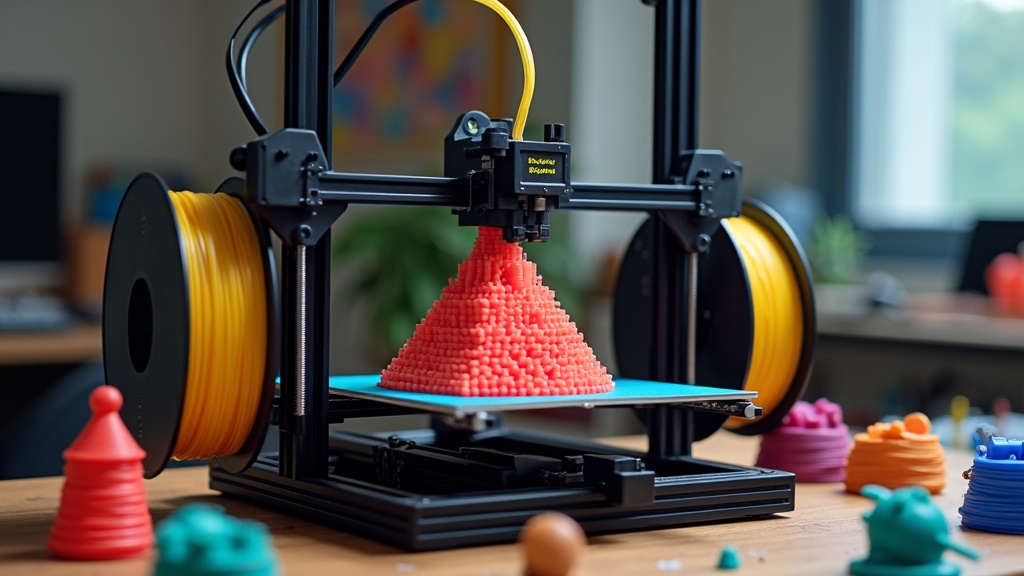Multicolor 3D printing is bringing a whole new creative dimension and more practical utility to home fabrication. If you love designing or printing multipart objects, adding vibrant color without time-consuming swaps opens up a world of possibilities. For years, printing in more than one color meant pausing your print at certain layers to manually swap filaments or installing tricky modifications. Today, the technology is moving fast, and several manufacturers are racing to become household names for color 3D printing.

Why Multicolor 3D Printing Is on Everyone’s Radar
Multicolor 3D printing is about more than just adding visual pop. For designers, engineers, and hobbyists, being able to print objects in several colors all at once means less post-processing and more creative freedom. When I tried multicolor printing for the first time, the results looked like they just rolled off a factory assembly line, right from my home printer. It felt like a big upgrade from single-color prototypes.
It might surprise newcomers just how much the world of 3D printing has switched up since multi-material and multicolor capabilities were introduced. Major brands and open source projects have jumped into the mix with practical, affordable solutions. This competition makes prices more reasonable and pushes print quality higher for everyone. Multicolor 3D printing is getting a lot more accessible today, much like desktop 3D printing did a decade ago. For a quick background on the basics of fused deposition modeling (FDM) and filament types, check out this beginner’s guide to 3D printing.
How Multicolor 3D Printing Works
Printing in more than one color typically uses one of two methods: a single nozzle that switches between filaments or combining several nozzles into a single print head. Both try to control which color comes out at which point, so you can make stripes, gradients, or sharp color changes right in your print.
The quickest way I’ve found to get into multicolor 3D printing is by adding a filament-changing device, like the Bambu Lab AMS or Prusa MMU, to your printer. These gadgets let the machine automatically switch between several filament spools during a print. Today, some printers come with multi-material print heads right out of the box. This makes it even simpler for beginners.
With these options, you can print custom keychains, toys, desktop organizers, or even functional parts that label themselves with color. It’s perfect for quick prototypes or giving gifts a real professional finish. Curious about slicing software and how color assignments work? There are some smart tips in this review of 3D printing software tools.
Choosing the Right Multicolor 3D Printer
Picking out a good multicolor 3D printer can feel overwhelming. These days, Bambu Lab, Prusa, and Qidi Tech are putting out highly reviewed machines built for multicolor jobs. There are a few key differences to pay attention to when sorting through your options:
- Number of Filament Inputs: Some printers offer two, four, or even eight spools at once. More inputs boost your color choices but can mean a higher price and extra complexity.
- System Type: Decide between a single-nozzle setup (which swaps filaments) and a multi-nozzle system (each extruder runs a different color). Single-nozzle models are the most common and are easy to maintain, while multi-nozzle printers offer real separation with no need for “purge towers.”
- Supported Materials: Make sure your printer can handle the workhorses—PLA, PETG, ABS—or whatever filaments you prefer. Some multicolor setups have trouble with flexible or rough filaments.
- Slicer Compatibility: Not every slicing program is great with multicolor jobs; support for the right software can really make or break the printing experience.
If you want specs and details on current multicolor-capable printers, check out this 3D printer comparison.
Quick Start: Getting Into Multicolor 3D Printing at Home
Getting started with multicolor 3D printing doesn’t have to break the bank or leave you confused. I followed these steps when I first tested the waters:
- Choose a Printer or Upgrade: If you already have a compatible 3D printer, adding an accessory like the Prusa MMU or Palette device can make it multicolor. Newcomers should shop for a machine with built-in multicolor support.
- Select Filaments: Pick colors that work nicely together and try to stick to reliable PLA filaments at first. The right filaments help sidestep a lot of problems.
- Pick or Design a Multicolor Model: Several sites offer ready-to-print models labeled for automatic color switching. Or, design your own using color-separated layers with CAD tools or color-mapping plugins.
- Adjust Slicer Settings: Assigning colors to each part and tweaking print settings matters. Tutorials specific to your setup are a huge help; don’t skip them.
- Try a Basic Print: Launch a simple, small design like a keychain or decorative badge. It’s the fastest way to spot any snags before you move on to bigger projects.
The best part is how flexible it feels. I remember changing up a color halfway through a print just to see what would happen, and the surprise made it worth it. If you need more advice on learning print basics or troubleshooting, check out this troubleshooting guide.
Things to Watch Out for When Printing in Multiple Colors
Getting pro results with multicolor 3D printing brings a fresh set of challenges. From experience, here are some recurring problems and my best fixes:
- Oozing and Color Bleed: Colors can blur between swaps. Well-tuned wipe and purge settings can help fix that.
- Filament Tangles and Jams: Juggling multiple spools ups your odds of tangling. I store my spools spaced out and always check for neat winding.
- Slow Print Times: Purging spent material at each change adds time. Efficient model design and optimized slicer settings can help things along.
- Software Setup: Multicolor setups can feel tricky. Step-by-step guides and online help forums taught me a ton that I couldn’t get from manuals alone.
Experimenting with your print settings is important—I keep a notebook to jot down color separation tricks and temperature tweaks that match the filaments I use most.
Oozing and Color Bleed
Switching from one color to another may leave a bit of old color inside the nozzle, which often mixes into the new color. Purge towers can catch this stray material, but carefully dialing in purge lengths and cleanups really makes the difference in quality.
Software Setup
Multicolor slicing feels a little different than working with single colors. Assigning colors to each part and handling tool changes is easiest when the software is made for your machine. Some companies offer slicers tailored to their own hardware; others leave more to user customization. If you’re new, look for video tutorials or detailed written guides focused on your model—they save a ton of frustration.
Practical Uses for Multicolor 3D Printing
There’s more to multicolor 3D printing than just eye-catching display models and toys. Here are practical ways I put it to work:
- Custom Labels: Add contrasting symbols or text to bins, organizers, or tools for instant recognition.
- Prototypes: Show off a part with color-coded features—great for explaining functions in school or design meetings.
- Personalized Gifts: Make a trinket or display piece in somebody’s favorite colors for a meaningful touch with no extra trouble.
- Educational Models: Bring to life complex systems, like color-coded maps or layered models for classrooms and demonstrations.
Color elevates learning, presenting, or organizing. These uses help your prints serve real functions, not just decorate your shelves. Check the 3D printing ideas roundup for project inspiration using multicolor designs.
Frequently Asked Questions
I get lots of questions when I show off multicolor prints. Here are some of the most frequent ones people ask:
Q: Can I turn any 3D printer into a multicolor printer?
A: Plenty of single extruder printers can be upgraded with accessories and add-ons. Check first that your firmware supports multi-material extensions, and then see what your printer’s manufacturer has to offer for your specific model.
Q: Is multicolor printing hard to set up?
A: There is a bit of a learning curve, but nothing overwhelming. If you already use slicing software, adding color/material settings is pretty intuitive with the right help. Spend a little time with video and written tutorials, and don’t hesitate to check in with online groups.
Q: Do multicolor prints cost more?
A: Multicolor jobs use more filament, especially for purge blocks and transitions, so you’ll spend a bit more compared to single color prints. You can limit waste by designing your models and setting up your slicer efficiently.
The Bottom Line on Multicolor Printing
Multi-color 3D printing is the natural next step if you’ve enjoyed making single-color items and want to bring more personality and clarity to your projects. A little extra setup unlocks a world of creative freedom. Now that printer makers are pushing to offer better solutions, prices have dropped, and user-friendliness has increased. Anyone curious about where desktop manufacturing is headed should keep an eye on this trend. For more reviews, how-tos, and ideas, check out 3D Printing by Kevin to keep up with the latest in 3D printing tips and tools.

